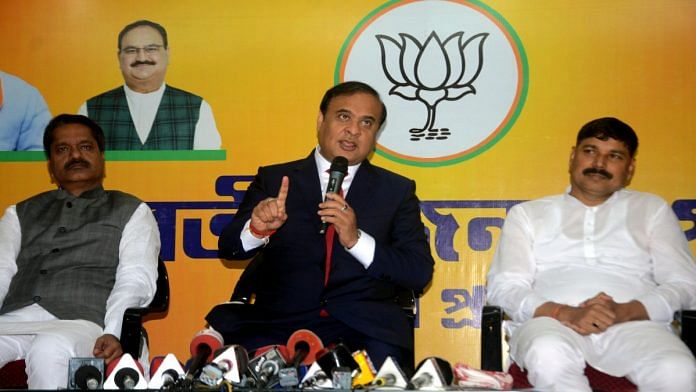Guwahati: The cabinet of Assam has designated five Assamese-speaking Muslim communities — Goriya, Moriya, Deshi, Julah, and Syed — as “indigenous”, a move that has been criticised as the ruling Bharatiya Janata Party’s attempt (BJP) to emphasise their “Assamese” identity and separate them from the larger population of “migrant” Bengali-speaking Muslims.
Chief Minister Himanta Biswa Sarma announced the decision in a tweet Tuesday and said that this would ensure development in health, cultural identity, education, financial inclusion, skill development, and the empowerment of women for these groups.
At our weekly #AssamCabinet, we took several decisions pertaining to scrapping of old vehicles, identification of 5 indigenous Muslim groups, exempting ex-servicemen & their widows from paying property tax, boost to renewable energy, improving data access, etc. pic.twitter.com/3a56XLQfd7
— Himanta Biswa Sarma (@himantabiswa) July 5, 2022
According to the 2011 census, 34.22 per cent of Assam’s population of 3.12 crore were Muslims.
Azizul Rahman, vice-president of a community organisation that claims to represent some of these groups, the All Assam Goriya-Moriya-Deshi Jatiya Parishad, told ThePrint that Assamese Muslim communities constitute “40 lakh of the [projected] 1.35 lakh Muslims” in the state.
Just before the assembly election in Assam last year, Sarma — then the state’s minister of health, education, and finance — had said that the BJP didn’t need votes from the “Bengali-origin” Muslim community, known as “Miyas”.
“These so-called Miya people are very, very communal and fundamental and they are involved in many activities to distort Assamese culture and Assamese language,” he had said.
In July last year, the Assam government constituted subcommittees to work out a roadmap for the “empowerment of the indigenous Muslim population of the state”, which the chief minister said would be implemented over a five-year period.
In May this year, the chief minister cited a report by a subcommittee to say that the indigenous Muslim population doesn’t want to “mix” with migrant Muslims in the state.
Discussing the party-political dimensions of the decision, Sushanta Talukdar, the editor of NEZINE — an online magazine that focusses on the northeast of India — told ThePrint, “The Congress and the All India United Democratic Front (AIUDF) have a strong support base among the erstwhile East Bengal-origin Muslims. Among the Assamese Muslims, there are certain organisations that want this segregation, so the BJP is using this as an opportunity.”
Some opposition parties alleged that the move would pit Muslims against each other.
“The BJP had for so many days have been talking about the religion and caste; now they want to create divisions among Muslims,” Aminul Islam, an MLA from the Badruddin Ajmal-led AIUDF — the third largest political party in the state after the Congress and the BJP — told ThePrint.
He added that the BJP was trying to woo the five Muslim groups, and said, “There is no established definition of ‘indigenous’ in Assam, or in India as a matter of fact.”
However, Assam BJP president Bhabesh Kalita rejected this criticism and said, ”It’s the Congress that was thinking in terms of vote bank,” he said. “They [the five Muslim groups] need upliftment. Infiltration is high in Assam; we need to protect the indigenous Muslims.”
Also Read: Yogi Adityanath and Himanta Biswa Sarma—two outsiders playing like pros in RSS-dominated BJP
‘Separate identity as indigenous people’
Rahman said that all five Muslim communities — Goriya, Moriya, Deshi, Syed, and Julha — had demanded a separate census after having faced harassment in the past.
“Sometimes in our community, Goriya, Moriya, Deshi, Syed, and Julha have wrongly been declared as foreigners. So there is a lot of harassment…but we are indigenous,” he said.
The communities, he said, live in small villages all over Assam and are politically deprived.
“So, our demand was a separate census and separate identity as indigenous people,” he said.
Akhil Ranjan Dutta, head of the political science department at Gauhati University, said that Assamese Muslims are a much smaller community than the Muslims from erstwhile East Bengal.
“So the tendency is that they don’t want to be antagonistic towards whichever government is in power.”
“It was the same during the Congress’s time [and it’s] not necessarily because of differences between in the communities,” he said, but acknowledged that there were class differences between Assamese and Bengali Muslims.
“The indigenous Muslims or Assamese Muslims belong to an aristocratic class, if you look at the upper Assam Muslims, they are educated, wealthy people,” Dutta said, “Bengali Muslims are predominantly poor peasants, making up [the state’s] migrant and labour class.”
Anti-immigrant discourse
The anti-immigrant discourse in Assam, which has its roots in the Assam Movement — an anti-immigrant movement in the state that lasted from 1979-85 — usually targets Bengali-speakers.
According to Talukdar, the Assamese nationalist identity was formerly primarily a linguistic identity, but the BJP is now trying to add a religious dimension to this.
“They are creating these various camps, so there’s the Hindus vs Muslims, the Assamese vs non-Assamese. But this may also raise concerns among the Bengali Hindus, where the BJP has a support base,” he said.
“The larger scheme,” he added, “is to say that the Bengali Muslims are posing a threat to the Assamese identity.”
Rejaul Karim Sarkar, president of the All Assam Minority Student’s Union (AAMSU), refused to offer a comment, saying that the organisation would make a decision at a meeting it will hold in Guwahati Thursday.
Like the AIUDF, AAMSU has strongly opposed the government’s decision to identify these groups as indigenous.
(This copy has been updated to reflect Azizul Rahman’s correct designation)
(Edited by Uttara Ramaswamy)
Also Read: ‘Never seen floods like this before’ — 134 dead, 21 lakh hit as 22 Assam districts battle deluge



